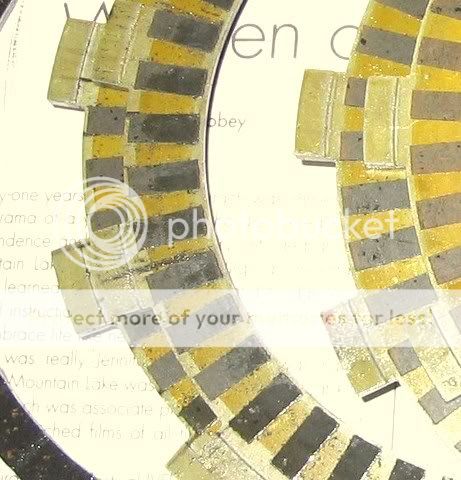vabrzn
Well-known member
I had the clutch sticking problem back in February when I bought my 2007 that has been brought up here. The sticking went away after 1500 miles, but I still couldn’t pull in the clutch and move the bike around the garage when the engine was cold without giving the bike a good push to break the plates lose; the bike has 17,000 miles on it now.
We had some rain and ice a couple of weeks so I decided to pull the clutch out and take a look at it. The inner three clutch plates were coated with thick black grease (it looked like grease anyway) and these plates were stuck to the friction plates. I needed to use a pick to carefully work the plates apart. I cleaned the plates with kerosene and put all the plates in oil for an overnight soak. The grease was preventing oil from getting to the plates.
I happened to put the pressure plate on my finger through the bearing opening and it was very much out of balance. I used a clutch alignment tool for a car, mounted and leveled in a vise to check the balance. Using stick on tire balancing weights it took ¾ ounce to balance the pressure plate. This seemed like a lot of weight for a six inch aluminum disk. I considered whether or not it was supposed to be like this or not and decided to balance the pressure plate by removing rough castings edges and some of the plate itself with a dremel tool. It took about an hour of carefully removing a little bit of material at a time to get it in balance.
Curiosity got the best of me and I pulled the clutch basket out to check it for balance. The clutch basket was essentially balanced, but I removed some material from the rough casting edges to get it balanced as much as I could.
My clutch now releases immediately regardless of engine temperature and I no longer need to put a slight preload on the shift lever to achieve very smooth shifting; much nicer.
I had a moderate amount of vibration in my foot pegs, side covers, and the trim piece on the bottom of the gas tank prior to doing this work. All of that vibration is gone and although I considered the bike to be smooth before, it is much more of what I expected when I bought the bike; happy!
I don’t know for sure if balancing the pressure plate had anything to do with eliminating the vibration or it had something to do with disassembly of the clutch. Anyway, I’m much happier with the bike now.
https://picasaweb.google.com/heise7/HeiserMcTrip/photo#5145860676757757618
We had some rain and ice a couple of weeks so I decided to pull the clutch out and take a look at it. The inner three clutch plates were coated with thick black grease (it looked like grease anyway) and these plates were stuck to the friction plates. I needed to use a pick to carefully work the plates apart. I cleaned the plates with kerosene and put all the plates in oil for an overnight soak. The grease was preventing oil from getting to the plates.
I happened to put the pressure plate on my finger through the bearing opening and it was very much out of balance. I used a clutch alignment tool for a car, mounted and leveled in a vise to check the balance. Using stick on tire balancing weights it took ¾ ounce to balance the pressure plate. This seemed like a lot of weight for a six inch aluminum disk. I considered whether or not it was supposed to be like this or not and decided to balance the pressure plate by removing rough castings edges and some of the plate itself with a dremel tool. It took about an hour of carefully removing a little bit of material at a time to get it in balance.
Curiosity got the best of me and I pulled the clutch basket out to check it for balance. The clutch basket was essentially balanced, but I removed some material from the rough casting edges to get it balanced as much as I could.
My clutch now releases immediately regardless of engine temperature and I no longer need to put a slight preload on the shift lever to achieve very smooth shifting; much nicer.
I had a moderate amount of vibration in my foot pegs, side covers, and the trim piece on the bottom of the gas tank prior to doing this work. All of that vibration is gone and although I considered the bike to be smooth before, it is much more of what I expected when I bought the bike; happy!
I don’t know for sure if balancing the pressure plate had anything to do with eliminating the vibration or it had something to do with disassembly of the clutch. Anyway, I’m much happier with the bike now.
https://picasaweb.google.com/heise7/HeiserMcTrip/photo#5145860676757757618





